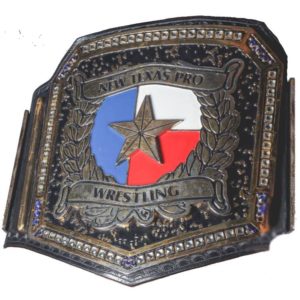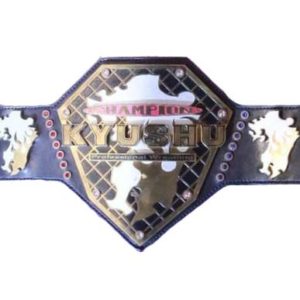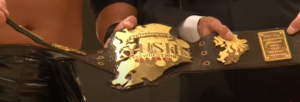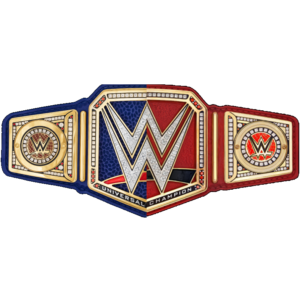As I mentioned last time, most of the roster and staff had left the company with Mitsuharu Misawa to form Pro Wrestling NOAH. The only people of note who stayed were Toshiaki Kawada, Jinsei Shinzaki, Taiyo Kea, and the long-time gaijin wrestlers. With no ability to build a new roster from scratch because of the massive walkout, AJPW had to go to rather drastic measures to survive. First, they brought back Genichiro Tenryu. Giant Baba had said Tenryu’s defection a decade earlier would mean he’d never be allowed in All Japan again. Well, this new defection trumped that one. Even with Tenryu, the July 2000 tour was paltry to say the least, so AJPW entered into a cross-promotional agreement with New Japan in August to stop some of the bleeding. They also relied on participation from Mexican wrestlers and Toryumon to fill in the gaps, something rather unheard of for the very insular All Japan.
As for the titles, they were all held by people who left for NOAH, so they all became vacant. The Triple Crown stayed that way for four months, until a tournament was held at the October Giant Series to crown a new champion. The field included Tenryu, Kawada, Shinzaki, Mike Barton, Johnny Smith, Steve Williams, New Japan’s Shiro Koshinaka, and a 51-year-old Stan Hansen.
October 28, 2000 – Tokyo, Japan
Genichiro Tenryu def. Toshiaki Kawada {Triple Crown Heavyweight Championship Match}
This was also AJ’s 28th Anniversary Show. As with most All Japan main events, I think they could have made the point they were trying to make in less time. That said, this match was brutal. Kawada would break down Tenryu with kicks, only for Tenryu to fire back with gnarly haymakers. Tenryu’s nose got caved in with a kick, knocking him off the apron. The result was gross. He came back with punches so hard that he had to take time to make sure his hand hadn’t been crushed. I loved that. In the end, the old man put Kawada down with Northern Lights Bomb at 26:38. ****¼
June, 8, 2001 – Tokyo, Japan
Keiji Mutoh def. Genichiro Tenryu {Triple Crown Heavyweight Championship Match}
From the Super Power Series. Tenryu held the title for ten months but only made one successful defense. He had defeated Mutoh for the IWGP title a year and a half earlier, so there’s some synergy here that I liked. Far be it from me to tell someone else why they liked a match that I liked less, but I feel like the gushing that folks have done over this match is nostalgia-fueled. I’ve never been the biggest Muta guy, so this match felt solid but decidedly unspectacular to me. I guess for me, All Japan main events are more aggressive than Mutoh ever really is, so his performance here didn’t blow me away. I think people were really excited to see Mutoh in a match where he clearly gave a shit, but that’s just not enough for me to lose my mind. He won the title with a moonsault at 23:24. A few months later, Mutoh defected to All Japan full time and brought Satoshi Kojima and Kendo Kashin with him. ***½
February 24, 2002 – Tokyo, Japan
Toshiaki Kawada def. Keiji Mutoh {Triple Crown Heavyweight Championship Match}
From the Excite Series. I liked this a lot more. It was a great mashup of the New Japan and All Japan styles. Mutoh tried to go strike for strike with Kawada. But when the Shining Wizard proved to be no match for Kawada’s kicks, he brought things to the mat and tried to put Kawada out with an extended Figure 4 Leglock. Kawada’s tree trunk legs withstood the assault. He came back with everything he had, eventually pinning a screaming Mutoh with three powerbombs (one Ganso) at 27:37. Kawada got hurt again and had to vacate the title again about a month later. ****
April 13, 2002 – Tokyo, Japan
Genichiro Tenryu def. Keiji Mutoh {Triple Crown Heavyweight Championship Match}
From the Grand Champion Carnival. Three days earlier, Mutoh won the Champion Carnival tournament. The title wasn’t up for grabs in the tournament because there were 30-minute time limits on tournament matches and title matches went 60 minutes. It seems the solution would be to allow the finals to go 60 minutes and then have the winner be forced to defend against anyone he had a draw with in the tournament. But instead Mutoh won (and in doing so became the first person to win the Carnival and the G1 Climax) and then just faced Tenryu for the title here. Tenryu mocking Mutoh with a Shining Wizard and pose was fun. The rest of the match was completely on par with the match from a year earlier. I did like Mutoh trying to kick his way out of the Northern Lights Bomb as it was happening to him, but still getting pinned at 19:38 regardless. A few months later, Mutoh was named President of All Japan and most of the company’s stock was transferred to him. ***½
October 27, 2002 – Tokyo, Japan
The Great Muta def. Genichiro Tenryu {Triple Crown Heavyweight Championship Match}
From Royal Road 30 Giant Battle. My kingdom for a match without Mutoh. I could be mistaken but I think this was only the second ever appearance of lizard Muta. This match was Muta wrecking Tenryu with a shot with the ring bell, Tenryu coming back by misting Muta (sort of, really he just spit a thick stream of red water into his face. It was gross), and then Muta steamrolled Tenryu with moonsaults. Buried in here somewhere is a cool story about Tenryu trying to be Muta and failing because Muta is obviously better at being Muta. But the action wasn’t compelling enough to carry that. The action wasn’t bad, it just wasn’t much beyond competent. Muta won in 17:12 with a moonsault. ***
February 23, 2003 – Tokyo, Japan
Shinya Hashimoto def. The Great Muta {Triple Crown Heavyweight Championship Match}
From the Excite Series. Yikes, next thing you know they’ll bring in Masahiro Chono to the Triple Crown picture. Hashimoto didn’t bring much to the table here, except as a canvas for his own blood and Muta’s mist. Muta was more vicious and gruesome than maybe I’d ever seen him before, so that was cool. Hashimoto got a little comeback and then picked up the win with a brainbuster at 20:09. Points for the gore and some decent fun. A few months later, Hashimoto dislocated his shoulder and the title was held up again. ***¼
September 6, 2003 – Tokyo, Japan
Toshiaki Kawada def. Shinjiro Ohtani {Triple Crown Heavyweight Championship Match}
From Summer Action Series II. This was the finals of a four man tournament also including Mike Awesome and Kojima. Not much of a tournament. Awesome attacked Kawada before this match and injured his leg. I didn’t know that ZERO1 had its tentacles so deep in All Japan in 2003. I had thought that Ohtani would look small compared to Kawada, but the truth is that Japanese main eventers aren’t all that big and Ohtani didn’t have to puff up much to look like a heavyweight. This was decent, but Ohtani didn’t go after the injured leg until late in the match. That makes no sense. You’re an outside up against the longest tenured guy in the company and you don’t go after his weakness? I guess that mistake cost him, as once Kawada escaped a leglock he just kicked Ohtani to pieces and got the win at 21:34. Kawada went on to have the second longest reign in the history of the title, after Misawa’s two-year stint with the belt. ***¼
February 16, 2005 – Tokyo, Japan
Satoshi Kojima def. Toshiaki Kawada {Triple Crown Heavyweight Championship Match}
From Realize. I wrote this review in ’07, so it’s got way too much play-by-play. But I’ve still got a lot of ground to cover with this title so no time for a rewatch. They lock up to start and Kojima hits a cheap shot. Kawada puts on a wristlock but Kojima forces him to the ropes. They trade strikes in an exchange that Kawada easily wins. Kawada starts working the leg but Kojima gets to the ropes. Kawada hits a roundhouse kick to the face for 2. He puts on a surfboard stretch but after a long struggle Kojima counters the hold. Kawada slaps him across the ring and hits a bodyslam. He kicks Kojima around for 2. Kojima hits a running forearm and an elbowdrop. He hits another elbowdrop and goes to climb the ropes. Kawada knocks him off the apron with a Yakuza kick. Kojima gets back on the apron so Kawada kicks him down again. He follows him out and rams him into the barricade before kicking his face. He hits a powerbomb on the floor and rolls Kojima back into the ring for 2. He unloads with kicks and chops and then puts on a half crab. Kojima gets to the ropes. He tries to strike Kawada down and gets knocked on his back as a result. Kawada hits a Yakuza kick in the corner and puts Kojima down for 2 with a lariat. He puts on the Stretch Plum then switches to a half nelson. Kojima hits the Koji Cutter and a tiger driver for 2. Kawada hits an enziguiri and a backdrop driver for 2. He hits a clothesline but Kojima doesn’t go down. Kojima fights through another clothesline and hits a brainbuster. He hits another brainbuster for 2. He hits lariat but Kawada comes back with a big boot. They hit simultaneous clotheslines before Kojima puts Kawada on his back with a lariat for 2. He puts on the Koji MAX but Kawada gets to the ropes. He hits Emerald Frosion for 2. He goes back to Koji MAX and then releases to get 2. Kawada hits a jumping enziguiri for 2. Kojima ducks a kick to the face but Kawada catches him with another enziguiri. He hits a backdrop driver and a powerbomb for 2. Kojima blocks an enziguiri and hits a lariat for 2. He hits another lariat for 1 and Kawada fires up. Kojima hits two more lariats for 2. Kawada gets up slowly this time and Kojima hits a final lariat the win and the title at 27:03. I reviewed this back then more because it was part one of a two-part historical event (paired with the near-60-minute match against Hiroyoshi Tenzan for the IWGP title four days later) and not so much because it was a great match. That’s not to say it was a bad match, it just never maintained a great pace for more than a minute or two at a time. The finish was rather anticlimactic as well. ***½
July 3, 2006 – Tokyo, Japan
Taiyo Kea def. Satoshi Kojima {Triple Crown Heavyweight Championship Match}
From Crossover. Kojima held the belt nearly as long as Kawada, and it’s kind of cool that Kea was rewarded for his loyalty by being the guy to end this reign. Unfortunately, Kea just wasn’t an elite level wrestler. He won the Champion Carnival to earn this shot. The crowds were starting to look real small. This straight up felt like it took place and was taped at a house show. If it were a house show and not a Gaora TV special, this would have been a reasonable main event (though the title change would have been a bigger surprise). As it is, it’s a perfectly acceptable TV-level main event that was saved by an action-packed second half. Kea won at 19:56 with the H5O. ***¼
September 3, 2006 – Sapporo, Hokkaido
Minoru Suzuki def. Taiyo Kea {Triple Crown Heavyweight Championship Match}
From Summer Impact. Kea had legitimized his reign by beating Kawada a month earlier. I have a theory about what happened in this match. I think that after Kea and Suzuki went hard at each other in the opening minutes of the match and the crowd didn’t react, they decided to take it easy for the remaining half hour. What I wish they’d done would have been to just cut half of the match. Truth is, it looked and sounded like there were just very few people in the audience, relatively speaking. The match wasn’t outright bad, but it just moved along at the same middling pace forever. Eventually, Suzuki put on a rear naked choke for the win at 34:52. **½
August 26, 2007 – Tokyo, Japan
Kensuke Sasaki def. Minoru Suzuki {Triple Crown Heavyweight Championship Match}
From Pro-Wrestling Love in Ryogoku Vol. 3. At this point, AJ was drawing under 5,000 fans to shows outside of Tokyo and between 8-10K in Tokyo. It wasn’t looking awesome. The sad thing is, these days they’d kill for a crowd of 8,000 even before the pandemic. Here, Sasaki becomes the fifth person to hold this title and the IWGP Heavyweight Championship after Vader, Keiji Mutoh, Shinya Hashimoto, and Satoshi Kojima (who had them at the same time). The first twenty minutes of this match almost completely lost me. They were all on the mat and the dynamic didn’t change enough to keep me interested. Suzuki worked on Sasaki’s arm forever. But it was almost worth it for the look on Suzuki’s face when Sasaki went for a takedown and his arm gave out. Almost. The second half was slow but dramatic, with Suzuki trying to psych out Sasaki by taking his lariats and remaining standing. That bit him in the ass, as he got hit with one lariat too many and fell at 42:07. Frankly, it made him look kind of dumb in the end, but you could also argue that he was punch drunk. Anyway, this was way too long but certainly not bad. ***¼
April 29, 2008 – Nagoya, Aichi
Suwama def. Kensuke Sasaki {Triple Crown Heavyweight Championship Match}
From Growin’ Up. Hiroshi Hase had replaced Stan Hansen as the president of the PWF, so it’s not surprising that Hase’s recruit Suwama got this push as the next great hope for the company only four years after his debut. He had just defeated Hiroshi Tanahashi in the finals of the Champion Carnival, and had fought to a draw with Sasaki during the tournament. Because they were playing up that these guys wrestle each other for thirty minutes before going down, the match sort of stayed at the same speed the whole time. It wasn’t slow so it wasn’t painful, but it never peaked in an interesting way. It also made the finish, where Suwama hit the Last Ride but only got two and then hit a frog splash for the win at 29:55, feel like it came out of nowhere. ***½
September 28, 2008 – Yokohama, Kanagawa
The Great Muta def. Suwama {Triple Crown Heavyweight Championship Match}
From the Flashing Tour. Muta came into this match as IWGP Heavyweight Champion. I was very bored by this. Muta seemed more interested in mugging to the crowd than in putting on a good show. Though truth be told, I don’t think much should have been expected of a 46-year-old Muta and it’s odd that he put himself in the position to be champion. There was one cool spot near the end, when Suwama went for the pin after a Last Ride and Muta escaped by misting him from his back. Beyond that this did very little for me. Muta hit the moonsault for the win at 24:52. So now the old man has both titles. Great. **½
March 14, 2009 – Tokyo, Japan
Yoshihiro Takayama def. The Great Muta {Triple Crown Heavyweight Championship Match}
From Pro-Wrestling Love in Ryogoku Vol. 7. Muta had both titles for three months, losing the IWGP belt to Tanahashi at Wrestle Kingdom in January. In this match I learned that Muta’s mask was glued to his head, as it was ripped off here to reveal a bunch of it stuck to his scalp. Also a lot of blood. Both guys bled quite a bit here. The rest of the match was a slow brawl with no heat. They picked up the pace a (very) little bit toward the end. The finish saw Takayama hit his German suplex for the win at 13:42. In a cute touch, Muta spit the mist as he was being pinned, but because of the positioning it just dissipated pathetically into the air. Takayama became the second person to hold this title, the IWGP Heavyweight Championship, and the GHC Heavyweight Championship. Sasaki had pulled off the feat the previous September when he beat Takeshi Morishima for the GHC belt. I’ll get to that one eventually. **¼
September 26, 2009 – Yokohama, Kanagawa
Satoshi Kojima def. Yoshihiro Takayama {Triple Crown Heavyweight Championship Match}
From the Flashing Tour. Now this is more like it. Get Muta out of here, I say. Yeah, Takayama is also over 40 here, but he’s able to tell a cohesive story without a ton of stalling and posing. Basically, he beats the crap out of Kojima, who bumps around like a pinball for him. Kojima fights back through a broken nose and finds his spots to do damage to Takayama’s equilibrium. A few well-timed lariats later and Kojima is the champion again at 16:32. ***½
March 21, 2010 – Tokyo, Japan
Ryota Hama def. Satoshi Kojima {Triple Crown Heavyweight Championship Match}
From Pro-Wrestling Love in Ryogoku Vol. 9. Okay, let’s talk about sumo wrestlers Hama and Akebono. I was obsessed with Dragon Gate from the first time I saw its wrestlers in ROH to when I took a break from watching wrestling in 2010. In 2008, Akebono showed up (yeah, the guy who had a sumo match with Big Show at WrestleMania 21) and got all involved in the Dream Gate and Triangle Gate pictures. I hated it. The guy couldn’t do anything and his immense size ran in massive contrast to the light heavyweights in Dragon Gate. Hama is shorter but almost as heavy and got into wrestling later than Akebono, yet he had a passionate if small following online with wrestling fans. That translated to him winning this title, though he was unsurprisingly a paper champion. As for the match, it solidified a new respect I have for Kojima. On so many occasions the guy showed he was really generous, putting the match before himself. Here, he put together a logical story, showing himself having trouble incorporating his typical offense because of Hama’s weight and relying more on Koji Cutters than his killer lariats. Hama was impressive too, not running out of gas in a longer match than you typically see from guys his size. I expected rest holds throughout, but there was only one and it was pretty brief. Hama paid tribute to his boss Mutoh with a (kind of bad) Shining Wizard and got the win with a Ryota Hammer at 20:15. The match didn’t quite make him feel like the main eventer he needed to be to win the titles, but it came close. I’m almost curious to see what Akebono’s upcoming title matches are like now. Almost, but not quite. ***
May 2, 2010 – Nagoya, Aichi
Minoru Suzuki def. Ryota Hama {Triple Crown Heavyweight Championship Match}
From Growin’ Up. Suzuki won the Champion Carnival for the second year in a row to earn this shot. I realize while watching this that the change in production style under Mutoh did the product no favors. The crowd was barely visible because of the dark lights. Perhaps that was done to take attention away from the fact that the crowds were smaller. But not being able to see the fans is what made things seems smaller. So did the heavy reliance on ringside cameras over the hard camera. It gave the shows a really indie/house show vibe. I think it was meant to make us feel closer to the action, but it made the action feel smaller. Regardless, this match ruled. They told a really basic story that worked so well. Suzuki was confounded in the beginning, unable to get any momentum going against Hama. But eventually the leg kicks he’d been hitting throughout the match started paying dividends and Hama was unable to get any speed behind he avalanches and splashes. Suzuki also fell short because of his stubborn desire to hit a cradle piledriver, but eventually that too paid off and he hit it for the win at 21:44. And thus ended the shortest championship reign to that point that didn’t stop because of a drug overdose or injury. I’m shocked at how much I enjoyed his little title reign. ***¾
August 29, 2010 – Tokyo, Japan
Suwama def. Minoru Suzuki {Triple Crown Heavyweight Championship Match}
From Pro-Wrestling Love in Ryogoku Vol. 10. Like other Suzuki matches, this was too long. But also like other Suzuki matches, he brings some excellent drama to the bout. I love that he becomes pretty much obsessed with a game plan and goes to great lengths to see it to its end. I also like that when he abandons that plan because of his pride he ends up losing here. He tried the whole match to choke Suwama out, often acting like a horror movie villain and popping up at surprising times behind Suwama to lock it in. But down the stretch he got into a headbutt war and wound up knocked out with lariats and a backdrop driver at 44:24. ****¼
During Suwama’s 14-month reign, Nobukazu Hirai was attacked backstage by TARU. He was badly injured and subsequently forced to retire from wrestling. Thankfully, he’s seemingly able to lead a completely normal life aside from not being able to perform. TARU was suspended indefinitely (as were others who stood by and didn’t stop the attack) and Mutoh took the blame as the president of the company. Mutoh resigned his position but remained a wrestler. He hung around in the midcard for two years, but then things got dramatic again. More on that when I come back for the next and final chapter in the Triple Crown title history.
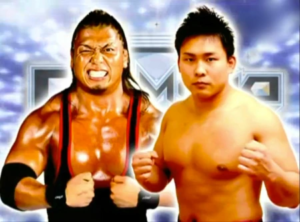 From Diamond Ring Kensuke Office Changes. They emphasize that Nakajima beat Dragon Gate wrestler Kenichiro Arai
From Diamond Ring Kensuke Office Changes. They emphasize that Nakajima beat Dragon Gate wrestler Kenichiro Arai  From Dynamite 131. This is a qualifying match for the Owen Hart Foundation tournament. Joe debuted at ROH Supercard of Honor, saving Jonathan Gresham from Jay Lethal (whose soul searching apparently led him to turn heel) & Sonjay Dutt after the main event. And now that ROH and AEW are the same thing, that seems worth mentioning. Caster’s pre-match rap was cute. This was real squashy, with Joe needing only two minutes to put Caster down with the Muscle Buster at 2:52. Lethal & Dutt pop up on the big screens and Lethal says he’d been trying to get a hold of Joe during his difficult soul searching time, and Joe never picked up. They have a present for Joe next week. N/A
From Dynamite 131. This is a qualifying match for the Owen Hart Foundation tournament. Joe debuted at ROH Supercard of Honor, saving Jonathan Gresham from Jay Lethal (whose soul searching apparently led him to turn heel) & Sonjay Dutt after the main event. And now that ROH and AEW are the same thing, that seems worth mentioning. Caster’s pre-match rap was cute. This was real squashy, with Joe needing only two minutes to put Caster down with the Muscle Buster at 2:52. Lethal & Dutt pop up on the big screens and Lethal says he’d been trying to get a hold of Joe during his difficult soul searching time, and Joe never picked up. They have a present for Joe next week. N/A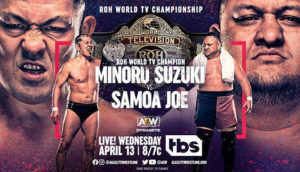 From Dynamite 132. Jay Lethal & Sonjay Dutt were in the front row cheering on Joe. Sarcastically, probably, as they brawled with Joe at ROH Supercard of Honor XV.
From Dynamite 132. Jay Lethal & Sonjay Dutt were in the front row cheering on Joe. Sarcastically, probably, as they brawled with Joe at ROH Supercard of Honor XV. 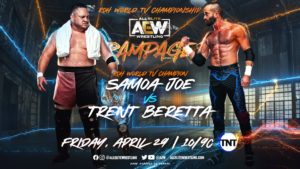 From Rampage 39.
From Rampage 39. 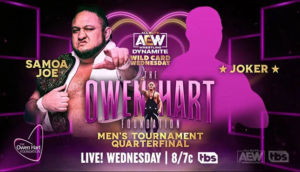 From Dynamite 137.
From Dynamite 137. 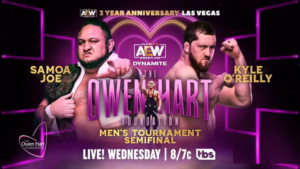 From Dynamite 138. This is a
From Dynamite 138. This is a 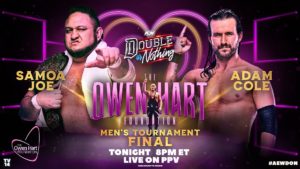 From Double or Nothing.
From Double or Nothing. 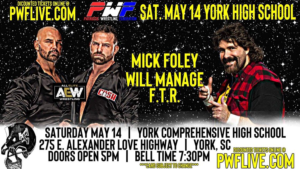 From PWF York Cougar Football Fundraiser. I didn't know that this match happened until over a month after the fact. This started out as a non-title match, but we'll get to why I've listed it as a title match in a moment. FTR have Mick Foley in their corner while their opponents have Bill Behrens. I’ve never actually seen Behrens do an on-camera gig before. He's holding a tennis racket, presumably as an Umaga to Jim Cornette. But it's confusing because there was actually a tennis player named Bill Behrens. They announce this match as having a 20-minute time limit. Only 11 minutes in, they say there are three minutes remaining. Until then, this was as run-of-the-mill as a modern FTR match gets. But the announcement snapped everyone out of their heat-on-Wheeler funk and forced them to go for desperate pins. They announce ten seconds remaining a couple of times, but no one can get the roll up pin they're looking for. The 20-minute time limit expires at 1
From PWF York Cougar Football Fundraiser. I didn't know that this match happened until over a month after the fact. This started out as a non-title match, but we'll get to why I've listed it as a title match in a moment. FTR have Mick Foley in their corner while their opponents have Bill Behrens. I’ve never actually seen Behrens do an on-camera gig before. He's holding a tennis racket, presumably as an Umaga to Jim Cornette. But it's confusing because there was actually a tennis player named Bill Behrens. They announce this match as having a 20-minute time limit. Only 11 minutes in, they say there are three minutes remaining. Until then, this was as run-of-the-mill as a modern FTR match gets. But the announcement snapped everyone out of their heat-on-Wheeler funk and forced them to go for desperate pins. They announce ten seconds remaining a couple of times, but no one can get the roll up pin they're looking for. The 20-minute time limit expires at 1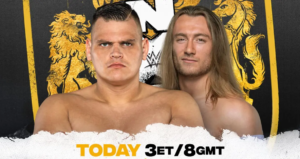 From NXT UK 183. McGuinness started by essentially saying that Fraser is going to pee or poo himself during the match. Unnecessary. Had Shawn Michaels been game to have a good match against Vader, this is what it would have looked like. Actually, a more appropriate and modern analogue is Brock Lesnar vs. Seth Rollins from SummerSlam. Much like that match, Frazer used quick strikes and avoided his larger opponent’s signature big move to stay alive. Here it was the powerbomb whereas there it was suplexes. Here, Frazer also successfully damaged WALTER’s knee, which slowed the big man down and made it hard for WALTER to hit the powerbomb. Unfortunately for Frazer, WALTER was able to bide his time and clothesline Frazer’s legs out from under him. An inevitable powerbomb followed and won the match for WALTER at 14:02. I hate to say this because I’m happy that he’s healthier, but the way WALTER has slimmed down has taken some of the magic away from his aura. At least for me it has. That said, dude can clearly still go as well as ever in the ring. ****
From NXT UK 183. McGuinness started by essentially saying that Fraser is going to pee or poo himself during the match. Unnecessary. Had Shawn Michaels been game to have a good match against Vader, this is what it would have looked like. Actually, a more appropriate and modern analogue is Brock Lesnar vs. Seth Rollins from SummerSlam. Much like that match, Frazer used quick strikes and avoided his larger opponent’s signature big move to stay alive. Here it was the powerbomb whereas there it was suplexes. Here, Frazer also successfully damaged WALTER’s knee, which slowed the big man down and made it hard for WALTER to hit the powerbomb. Unfortunately for Frazer, WALTER was able to bide his time and clothesline Frazer’s legs out from under him. An inevitable powerbomb followed and won the match for WALTER at 14:02. I hate to say this because I’m happy that he’s healthier, but the way WALTER has slimmed down has taken some of the magic away from his aura. At least for me it has. That said, dude can clearly still go as well as ever in the ring. ****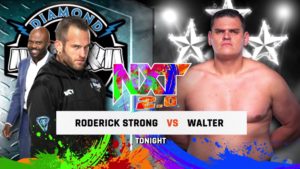 From NXT 659. Strong was feeling it here, which is thanks in large part to the crowd being maniacally loud from the get go I’m sure. His whole game was fast and devastating stick and move attacks. That worked pretty well, as WALTER was dazed from time to time. But as with all good WALTER matches (which is pretty much all WALTER matches), everything WALTER does is devastating here so it takes very little for him to take back control. And eventually he did just that and hit the powerbomb for the win at 9:46 (shown of 12:18). After the match, WALTER gets on the microphone and says that his name is Gunther now. I did not think WALTER would be a victim of the renaming curse this far into his run. What will they rename Strong?! ***¾
From NXT 659. Strong was feeling it here, which is thanks in large part to the crowd being maniacally loud from the get go I’m sure. His whole game was fast and devastating stick and move attacks. That worked pretty well, as WALTER was dazed from time to time. But as with all good WALTER matches (which is pretty much all WALTER matches), everything WALTER does is devastating here so it takes very little for him to take back control. And eventually he did just that and hit the powerbomb for the win at 9:46 (shown of 12:18). After the match, WALTER gets on the microphone and says that his name is Gunther now. I did not think WALTER would be a victim of the renaming curse this far into his run. What will they rename Strong?! ***¾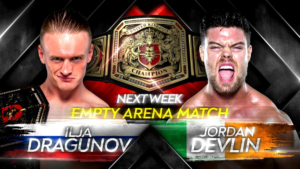 From NXT UK 185. Andy Shepherd helpfully announces from inside the ring that the reason for the stipulation is that the feud has gotten so violent that it wouldn’t be safe to have fans around. Devlin says during the match that it’s because he thinks Dragunov could only muster the energy to win if he had the crowd behind him. I like that explanation a lot more. The only real reason I could think of to do this without fans is that there was a scheduling conflict with one of the wrestlers for the regular TV taping date and they needed to get this thing filmed. We just had such a long stretch of empty arena NXT UK episodes that I can’t imagine anyone was dying to get another taste of it. This aired the day after Adam Cole vs. Orange Cassidy in a match that was also no disqualification and falls count anywhere, and this served up everything I felt was missing from that match. Now you might say, “Brad, Cassidy is not the same kind of character as Devlin or Dragunov, how could you expect the same level of violence or intensity?” To that I say, when Cassidy started his match by breaking his own sunglasses and rapidly punching Cole, he was indicating that level of violence and/or intensity. And instead the match was mostly wacky. Anyway, this was not wacky. It was stiff and intense and featured weapons that made sense and spots the didn’t take forever to set up. Dragunov got in trouble when his eye injury acted up. Devlin took control and beat the crap out of him. I wasn’t wild about how meek Dragunov was when Devlin was zip tying his hands, but I did like that in the end it turned out to be an error on Devlin’s part anyway because Dragunov’s finisher requires no hands. And indeed, a bound Dragunov jumped off the steel steps (which had been brought into the ring) and hit the Torpedo Moskau on Devlin for the win at 21:43. NXT UK is still sneaking in these dope matches that no one is watching. Y’all should watch them. ****¼
From NXT UK 185. Andy Shepherd helpfully announces from inside the ring that the reason for the stipulation is that the feud has gotten so violent that it wouldn’t be safe to have fans around. Devlin says during the match that it’s because he thinks Dragunov could only muster the energy to win if he had the crowd behind him. I like that explanation a lot more. The only real reason I could think of to do this without fans is that there was a scheduling conflict with one of the wrestlers for the regular TV taping date and they needed to get this thing filmed. We just had such a long stretch of empty arena NXT UK episodes that I can’t imagine anyone was dying to get another taste of it. This aired the day after Adam Cole vs. Orange Cassidy in a match that was also no disqualification and falls count anywhere, and this served up everything I felt was missing from that match. Now you might say, “Brad, Cassidy is not the same kind of character as Devlin or Dragunov, how could you expect the same level of violence or intensity?” To that I say, when Cassidy started his match by breaking his own sunglasses and rapidly punching Cole, he was indicating that level of violence and/or intensity. And instead the match was mostly wacky. Anyway, this was not wacky. It was stiff and intense and featured weapons that made sense and spots the didn’t take forever to set up. Dragunov got in trouble when his eye injury acted up. Devlin took control and beat the crap out of him. I wasn’t wild about how meek Dragunov was when Devlin was zip tying his hands, but I did like that in the end it turned out to be an error on Devlin’s part anyway because Dragunov’s finisher requires no hands. And indeed, a bound Dragunov jumped off the steel steps (which had been brought into the ring) and hit the Torpedo Moskau on Devlin for the win at 21:43. NXT UK is still sneaking in these dope matches that no one is watching. Y’all should watch them. ****¼ 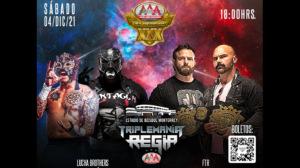 From AAA Triplemania Regia. FTR come out with Vickie Guerrero. This was supposed to be explained at an earlier AAA taping but FTR and Guerrero all missed them. AAA is notorious for having this kind of luck/being incompetent lately. FTR is also wearing Eddie Guerrero tribute tights, with American flags on one side and flames on the other, I suppose to pay homage to his Gringos Locos and Latino Heat gimmicks. This match mostly sucked, but one cool spot saw FTR tie Pentagon’s mask to the ropes and force him to unmask with his hands over his face to stop them from climbing the ladder. That would have been a very meaningful moment to lead up to the Lucha Brothers winning the titles back, but unfortunately instead it led into nothing. He just got his mask back and the match continued on in its lame, derivative way. At one point, Pentagon was the only man standing, but instead of climbing the ladder he grabbed a table from the floor. So the titles mean enough to him that he’d unmask to stop his opponents from winning, but not enough for him to get the titles when he had a clear path to do it? Vickie powered Pentagon, causing him to voluntarily jump through the table and Harwood grabbed the belts at 12:12. This was abysmal. *
From AAA Triplemania Regia. FTR come out with Vickie Guerrero. This was supposed to be explained at an earlier AAA taping but FTR and Guerrero all missed them. AAA is notorious for having this kind of luck/being incompetent lately. FTR is also wearing Eddie Guerrero tribute tights, with American flags on one side and flames on the other, I suppose to pay homage to his Gringos Locos and Latino Heat gimmicks. This match mostly sucked, but one cool spot saw FTR tie Pentagon’s mask to the ropes and force him to unmask with his hands over his face to stop them from climbing the ladder. That would have been a very meaningful moment to lead up to the Lucha Brothers winning the titles back, but unfortunately instead it led into nothing. He just got his mask back and the match continued on in its lame, derivative way. At one point, Pentagon was the only man standing, but instead of climbing the ladder he grabbed a table from the floor. So the titles mean enough to him that he’d unmask to stop his opponents from winning, but not enough for him to get the titles when he had a clear path to do it? Vickie powered Pentagon, causing him to voluntarily jump through the table and Harwood grabbed the belts at 12:12. This was abysmal. * From AEW Full Gear. Silver was hamming it up a lot more here than he was the year before in New York. That said, this had stronger just-a-match vibes than the aforementioned match. After Silver ripped out Cassidy’s pockets, Cassidy turned up the heat and these guys put on a middle of the row undercard match. Not bad by any means, but nothing memorable either. Cassidy hit the Beach Break rather out of nowhere for the win at 9:42. **¾
From AEW Full Gear. Silver was hamming it up a lot more here than he was the year before in New York. That said, this had stronger just-a-match vibes than the aforementioned match. After Silver ripped out Cassidy’s pockets, Cassidy turned up the heat and these guys put on a middle of the row undercard match. Not bad by any means, but nothing memorable either. Cassidy hit the Beach Break rather out of nowhere for the win at 9:42. **¾ 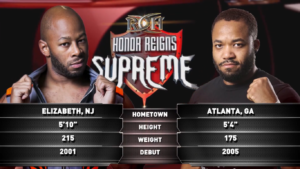 From the second Honor Reigns Supreme. The commentators sold this as Gresham getting a big shot against a top ROH guy after being an also-ran in the Television Championship division for a while. This was terrific. Both guys did a fantastic job selling their respective targeted limbs, and Gresham in particular played the role of the tenacious underdog perfectly. He didn’t just watch to see where Lethal would have trouble executing his finisher because of the damage he’d done to the former ROH Champion’s arm, he pressed the assault whenever he could, taking out the arm to make sure the Lethal Injection would never come. But what he couldn’t do was stop Lethal from battering his knee and ultimately winning with a Figure 4 Leglock at 17:54. ****¼
From the second Honor Reigns Supreme. The commentators sold this as Gresham getting a big shot against a top ROH guy after being an also-ran in the Television Championship division for a while. This was terrific. Both guys did a fantastic job selling their respective targeted limbs, and Gresham in particular played the role of the tenacious underdog perfectly. He didn’t just watch to see where Lethal would have trouble executing his finisher because of the damage he’d done to the former ROH Champion’s arm, he pressed the assault whenever he could, taking out the arm to make sure the Lethal Injection would never come. But what he couldn’t do was stop Lethal from battering his knee and ultimately winning with a Figure 4 Leglock at 17:54. ****¼ 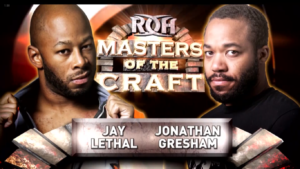 From the second Masters of the Craft. Columbus has way more Gresham fans than Concord did. That’s a neat little advancement to the plot, innit? They both went after the same limbs that earned them dividends in their previous match. And then they went ahead and built an incredible match out of that story. At first it seemed as though Lethal wasn’t going to be able to get Gresham’s leg to give out. But about halfway through the match, Gresham’s knee was in trouble. Gresham was able to escape the leglock this time by using the momentum of Lethal pulling him away from the ropes to shift to an armbar. But Gresham’s focus on the arm bit him in the ass. Lethal went for the Lethal Injection and collapsed again, but when Gresham went for a roll up after that Lethal cut back on it for the win at 18:27. This is one of the best American examples that I've seen of a match building on the match that came before. Rather than try to outdo the maneuvers from their first meeting for the sake of a big crowd reaction, they adjust their game plans in logical ways that, to me, were just as exciting. I think this match is slept on, by virtue of the fact that I’ve never heard anything about it before watching it. ****½
From the second Masters of the Craft. Columbus has way more Gresham fans than Concord did. That’s a neat little advancement to the plot, innit? They both went after the same limbs that earned them dividends in their previous match. And then they went ahead and built an incredible match out of that story. At first it seemed as though Lethal wasn’t going to be able to get Gresham’s leg to give out. But about halfway through the match, Gresham’s knee was in trouble. Gresham was able to escape the leglock this time by using the momentum of Lethal pulling him away from the ropes to shift to an armbar. But Gresham’s focus on the arm bit him in the ass. Lethal went for the Lethal Injection and collapsed again, but when Gresham went for a roll up after that Lethal cut back on it for the win at 18:27. This is one of the best American examples that I've seen of a match building on the match that came before. Rather than try to outdo the maneuvers from their first meeting for the sake of a big crowd reaction, they adjust their game plans in logical ways that, to me, were just as exciting. I think this match is slept on, by virtue of the fact that I’ve never heard anything about it before watching it. ****½ 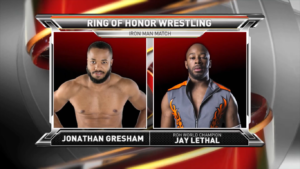 From ROH Wrestling 364. In real life,
From ROH Wrestling 364. In real life, 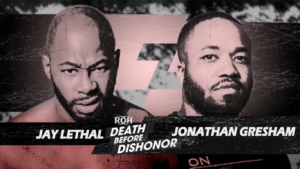 From Death Before Dishonor XVII. Gresham and Lethal had been teaming, but Gresham grew frustrated and started heeling. Ultimately, he turned on Lethal. It took them a little while to get there, but once they got into a groove this was exactly what I wanted from this match. It was back to their old tricks, with Lethal targeting the leg to set up for the Figure 4 Leglock and Gresham targeting the arm to block the Lethal Injection and set up for his Octopus. In the end, Lethal tried the cutback trick that worked for him in Columbus, but Gresham countered to a pin and then put on the gnarliest Octopus for his first win over Lethal at 17:20. This is the best kind of wrestling series. And none of it felt stale because it was a year after they’d wrestled last and because they found ways to energize the old tropes. And that’s not to mention Gresham busting out what I can only describe as a sumo-style assault. Gresham and Lethal make up after the match. ****
From Death Before Dishonor XVII. Gresham and Lethal had been teaming, but Gresham grew frustrated and started heeling. Ultimately, he turned on Lethal. It took them a little while to get there, but once they got into a groove this was exactly what I wanted from this match. It was back to their old tricks, with Lethal targeting the leg to set up for the Figure 4 Leglock and Gresham targeting the arm to block the Lethal Injection and set up for his Octopus. In the end, Lethal tried the cutback trick that worked for him in Columbus, but Gresham countered to a pin and then put on the gnarliest Octopus for his first win over Lethal at 17:20. This is the best kind of wrestling series. And none of it felt stale because it was a year after they’d wrestled last and because they found ways to energize the old tropes. And that’s not to mention Gresham busting out what I can only describe as a sumo-style assault. Gresham and Lethal make up after the match. ****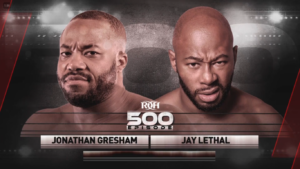 From ROH Wrestling 500. During the pandemic, ROH made the most of their empty arena shows by kicking them off with a tournament to crown a champion for the revived Pure Championship. Gresham won the tournament, and this was his fourth defense of the title. Lethal and Gresham were still allies here. In an interesting move, the other match on this milestone episode was two other partners fighting in Jay and Mark Briscoe. They cut to a commercial break about six minutes in, though the action didn’t get beyond (admittedly fast-moving) mat wrestling until the 10-minute mark. That had me thinking this was going to go long, but things took a different turn. Both guys had abused the other’s shoulders, and Lethal used that to his advantage best. He forced Gresham to use his first rope break to stop a pin, and his second to escape a crab. Then, he used the failed Lethal Injection to bait Gresham into a crossface, forcing the champ to use his final rope break. But he made the mistake of giving Gresham a breather and was quickly caught in a head scissor takedown giving Gresham the winning pin at 14:06 (shown of 16:40). For an empty arena match, this held my attention. It was totally different than their previous matches while still using a couple elements from the rivalry to elevate it just a bit. Not essential viewing, but if you’re working your way through their series you shouldn’t skip it. ***¼
From ROH Wrestling 500. During the pandemic, ROH made the most of their empty arena shows by kicking them off with a tournament to crown a champion for the revived Pure Championship. Gresham won the tournament, and this was his fourth defense of the title. Lethal and Gresham were still allies here. In an interesting move, the other match on this milestone episode was two other partners fighting in Jay and Mark Briscoe. They cut to a commercial break about six minutes in, though the action didn’t get beyond (admittedly fast-moving) mat wrestling until the 10-minute mark. That had me thinking this was going to go long, but things took a different turn. Both guys had abused the other’s shoulders, and Lethal used that to his advantage best. He forced Gresham to use his first rope break to stop a pin, and his second to escape a crab. Then, he used the failed Lethal Injection to bait Gresham into a crossface, forcing the champ to use his final rope break. But he made the mistake of giving Gresham a breather and was quickly caught in a head scissor takedown giving Gresham the winning pin at 14:06 (shown of 16:40). For an empty arena match, this held my attention. It was totally different than their previous matches while still using a couple elements from the rivalry to elevate it just a bit. Not essential viewing, but if you’re working your way through their series you shouldn’t skip it. ***¼ 